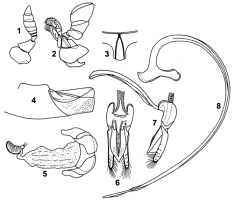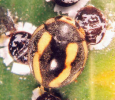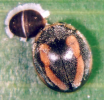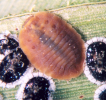Scientific name
Cryptogonus kapuri Ghorpade
Taxonomic position
Coleoptera: Coccinellidae: Scymninae: Aspidimerini
Diagnosis
Length 2.1-2.8 mm, width 1.9-2.2 mm. Form short oval, widest around middle, dorsum moderately convex. Head yellow, sometimes with a black median spot. Pronotum black, except anterior margin and anterolateral corners yellow. Scutellum black. Elytra black, external margins with an irregular yellow stripe terminating a little before apex, discal area with a yellow band, not touching base and apex of elytra. Elytral pattern variable, with median band sometimes split into two distinct elongate spots or confluent with marginal stripe in varying degrees. Antenna (Fig. 1) nine-segmented. Maxillary palp (Fig. 2) with terminal segment transverse. Prosternal process with an inverted Y-shaped carina (Fig. 3). Post-coxal line (Fig. 4) on first abdominal ventrite incomplete, apically merging with posterior margin of first ventrite. Male genitalia (Figs 6-8) and female spermatheca (Fig. 5) as illustrated. Larva scale-like, ellipsoidal in outline, light brownish grey without any dorsal
protuberances.
 Figs. 1-8. Cryptogonus kapuri Ghorpade: 1. Antenna; 2. Maxilla; 3. Prosternal intercoxal process; 4. Postcoxal line on abdominal ventrite 1; 5. Female genitalia; 6-8. Male genitalia: 6. Tegmen, ventral view; 7. Tegmen, lateral view; 8. Sipho
Figs. 1-8. Cryptogonus kapuri Ghorpade: 1. Antenna; 2. Maxilla; 3. Prosternal intercoxal process; 4. Postcoxal line on abdominal ventrite 1; 5. Female genitalia; 6-8. Male genitalia: 6. Tegmen, ventral view; 7. Tegmen, lateral view; 8. SiphoImages


 Adult feeding on Cerataphis brasiliensis on coconut Adult feeding on Cerataphis brasiliensis on coconut


 Larvae feeding on C. brasiliensis on coconut Larvae feeding on C. brasiliensis on coconut
 Pupa Pupa
Distribution
India: Karnataka; Tamil Nadu.
Prey / Associated habitat
HEMIPTERA: Aphididae: Coconut aphid, Cerataphis brasiliensis (Hempel)
(=Cerataphis variabilis Hille Ris Lambers). Feeds and breeds exclusively on this species in the field and on Toxoptera odinae (van der Goot) in the laboratory (Ghorpade, 1974). Coccoidea:
Aspidiotus destructor Signoret; Coccus viridis (Green).
Seasonal occurrence
Active in nature during January, June-July, and September-October in and around Bangalore.
Reference
- Ghorpade, K.D. 1974. Description of a new Cryptogonus Mulsant from Bangalore, Southern India (Coleoptera: Coccinellidae). Oriental Insects, 8, 55-60
(detailed description, illustrations of elytral pattern variations and genitalia).
|